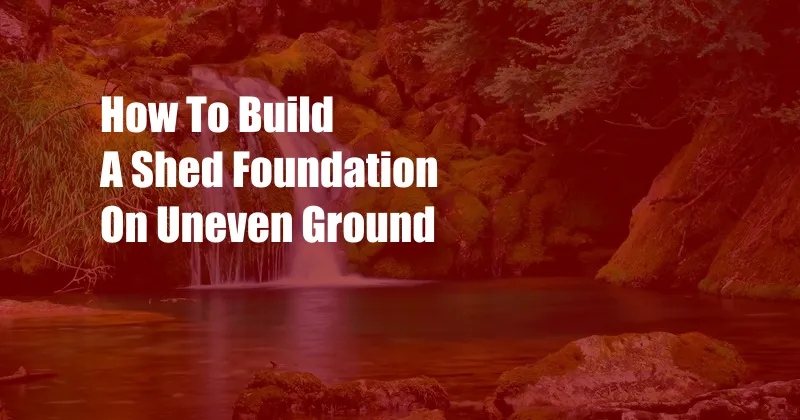
How to Build a Shed Foundation on Uneven Ground: A Comprehensive Guide
In the realm of home improvement, building a shed is a project that often begins with the task of establishing a solid foundation. However, the presence of uneven ground can pose a significant challenge. In this detailed guide, we’ll provide you with a comprehensive overview of how to build a shed foundation on uneven ground, ensuring a stable and durable structure.
Leveling the Ground: The First Step
Before constructing the foundation, it’s crucial to level the ground. Use a spirit level to assess the slope of the ground and identify areas that need to be raised or lowered. Mark these areas with stakes or spray paint. To raise low spots, fill them with gravel, sand, or soil and compact it firmly. To lower high spots, dig out the excess soil and level the remaining area.
Choosing the Right Foundation Type
Once the ground is level, you can choose the appropriate foundation type.
-
Concrete Slab: A concrete slab provides a level and stable base for your shed. It’s commonly used on level or slightly sloping ground.
-
Pier Foundation: Pier foundations are ideal for uneven ground. Piers are concrete or metal posts that are driven into the ground and support the shed’s weight.
-
Block Foundation: Block foundations are made of concrete blocks that are stacked on top of each other. They can be used on slopes or uneven ground, but are less stable than concrete slabs.
Building the Foundation: Step-by-Step Instructions
Concrete Slab:
-
Dig a perimeter trench around the shed’s outline. The width should be 6-8 inches and the depth should be 1-2 feet.
-
Fill the trench with gravel or crushed stone and compact it firmly. This will create a drainage layer.
-
Pour a 4-inch thick layer of concrete over the drainage layer and smooth it with a screed.
-
Allow the concrete to cure for at least 7 days before proceeding.
Pier Foundation:
-
Dig holes for the piers. The holes should be 2-3 feet deep and spaced 4-6 feet apart.
-
Set the piers in the holes and backfill with concrete.
-
Allow the concrete to cure for at least 3 days.
-
Install a beam or joists on top of the piers to support the shed floor.
Block Foundation:
-
Dig a perimeter trench around the shed’s outline. The width should be 12-16 inches and the depth should be 1-2 feet.
-
Fill the trench with gravel or crushed stone and compact it firmly.
-
Lay a layer of concrete blocks on the gravel bed.
-
Stack the blocks on top of each other, alternating the direction of the joints for stability.
-
Backfill the trench with soil and compact it.
Tips and Expert Advice
-
Use a laser level to ensure accuracy when leveling the ground and pouring the concrete slab.
-
Add rebar to the concrete slab for added strength and reinforcement.
-
Slope the ground away from the shed to prevent water from pooling around the foundation.
-
Use adjustable piers for pier foundations to accommodate uneven slopes.
FAQ
Q: What is the best foundation type for uneven ground?
A: Pier foundations are the most suitable for uneven ground, as they can be adjusted to accommodate slopes.
Q: How deep should I dig the holes for the piers?
A: The holes for the piers should be 2-3 feet deep and spaced 4-6 feet apart.
Q: How long does it take for a concrete slab to cure?
A: A concrete slab typically takes 7 days to fully cure.
Conclusion
Building a shed foundation on uneven ground can be challenging, but by following the steps outlined in this guide, you can ensure a stable and durable base for your shed. Whether you choose a concrete slab, pier foundation, or block foundation, careful planning and proper execution will lead to a successful project.
Are you ready to tackle the task of building a shed foundation on uneven ground? Share your experiences or ask any additional questions in the comments below!